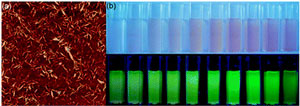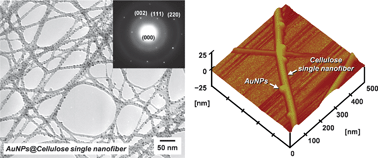This month sees the following articles in ChemComm that are in the top ten most accessed:-
Lighting porphyrins and phthalocyanines for molecular photovoltaics
M. Victoria Martínez-Díaz, Gema de la Torre and Tomás Torres
Chem. Commun., 2010, 46, 7090-7108, DOI: 10.1039/C0CC02213F , Feature Article
Advances in selective conversions by heterogeneous photocatalysis
Giovanni Palmisano, Elisa García-López, Giuseppe Marcì, Vittorio Loddo, Sedat Yurdakal, Vincenzo Augugliaro and Leonardo Palmisano
Chem. Commun., 2010, 46, 7074-7089, DOI: 10.1039/C0CC02087G , Feature Article
A “switching on” fluorescent chemodosimeter of selectivity to Zn2+ and its application to MCF-7 cells
Zhanxian Li, Mingming Yu, Lifeng Zhang, Ming Yu, Jinxia Liu, Liuhe Wei and Hongyan Zhang
Chem. Commun., 2010, 46, 7169-7171, DOI: 10.1039/C0CC01687J , Communication
Aryne cycloaddition: highly efficient chemical modification of graphene
Xing Zhong, Jun Jin, Shuwen Li, Zhiyong Niu, Wuquan Hu, Rong Li and Jiantai Ma
Chem. Commun., 2010, 46, 7340-7342, DOI: 10.1039/C0CC02389B, Communication
Host–guest chemistry with bi- and tetra-nuclear macrocyclic metallasupramolecules
Ying-Feng Han, Hao Li and Guo-Xin Jin
Chem. Commun., 2010, 46, 6879-6890, DOI: 10.1039/C0CC00770F, Feature Article
Copper N-heterocyclic carbene (NHC) complexes as carbene transfer reagents
Marc R. L. Furst and Catherine S. J. Cazin
Chem. Commun., 2010, 46, 6924-6925, DOI: 10.1039/C0CC02308F, Communication
Thermosensitive gating effect and selective gas adsorption in a porous coordination nanocage
Dan Zhao, Daqiang Yuan, Rajamani Krishna, Jasper M. van Baten and Hong-Cai Zhou
Chem. Commun., 2010, 46, 7352-7354, DOI: 10.1039/C0CC02771E , Communication
Controlled growth of inorganic nanocrystals: size and surface effects of nuclei
Shuling Shen and Xun Wang
Chem. Commun., 2010, 46, 6891-6899, DOI: 10.1039/C0CC00900H , Feature Article
Golf ball-shaped PLGA microparticles with internal pores fabricated by simple O/W emulsion
Mi Ri Kim, Seungwoo Lee, Jung-Ki Park and Kuk Young Cho
Chem. Commun., 2010, 46, 7433-7435, DOI: 10.1039/C0CC01738H , Communication
High-connected mesoporous metal–organic framework
Xiaojun Gu, Zhang-Hui Lu and Qiang Xu
Chem. Commun., 2010, 46, 7400-7402, DOI: 10.1039/C0CC02808H , Communication
Why not take a look at the articles today and blog your thoughts and comments below.
Fancy submitting an article to ChemComm? Then why not submit to us today or alternatively email us your suggestions.


















 We are delighted to invite nominations for the very first ChemComm Emerging Investigator Lectureship. The lectureship, which will be awarded annually, will recognise an emerging scientist in the early stages of their independent academic career.
We are delighted to invite nominations for the very first ChemComm Emerging Investigator Lectureship. The lectureship, which will be awarded annually, will recognise an emerging scientist in the early stages of their independent academic career.